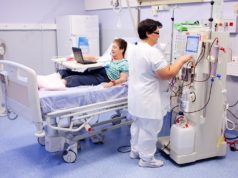 A large, single-centre retrospective study has revealed the risk of acute kidney injury (AKI) following pharmacomechanical thrombolysis (PMT) for lower extremity deep vein thrombosis (DVT) is as high as 22%.
A large, single-centre retrospective study has revealed the risk of acute kidney injury (AKI) following pharmacomechanical thrombolysis (PMT) for lower extremity deep vein thrombosis (DVT) is as high as 22%.
PMT is an established treatment for selected patients with acute DVT. Despite significant clinical success, haemolysis can lead to AKI with unknown longer-term implications. Researchers in the USA therefore aimed to characterise the rate of AKI after PMT, and identify those patients at the greatest risk.
“Recent evidence has suggested that catheter-direct therapy (CDT) in the setting of acute iliofemoral DVT improves vein patency and post-thrombotic severity with an equivocal risk of bleeding,” said principal author Karim M Salem (University of Pittsburgh, Pittsburgh, USA).
“Catheter thrombolysis can be accomplished by dripping thrombolytic agents through a multiside-hole catheter over several hours, or using PMT devices,” Salem added. “Plenty of evidence has supported the use of PMT over catheter thrombolysis because PMT can achieve fast lytic therapy at a lower tissue plasminogen activator (tPA) dose. Aggressive PMT, however, can cause haemolysis, which can result in AKI.”
As reported in the July 2021 issue of the Journal of Vascular Surgery: Venous and Lymphatic Disorders, Salem’s team studied the records of 137 patients who underwent PMT for acute iliofemoral DVT at the University of Pittsburgh between 2007 and 2018.
The mean age of the 137 patients was 47±17 years, 50% were male, and their preoperative creatinine levels were found to be 0.99mg/dL, on average.
Ultimately, 30 of these patients (22%) developed postoperative AKI, defined as a creatinine 1.5x baseline. According to the report, multivariable analysis demonstrated three significant risks factors for the development of AKI:
- Bilateral DVT (odds ratio=4.35, p=0.008)
- Single-session PMT (odds ratio=3.05, p=0.046)
- Female sex (odds ratio=2.85, p=0.046)
Of the 30 patients who did develop AKI, two progressed to severe renal failure (glomerular filtration rate <30ml/min) and one required long-term haemodialysis.
“Contemporary studies have reported the results of more rapid and aggressive thrombolysis protocols that can be completed in a single session,” Salem noted. “This approach has been associated with a development of acute renal failure owing to the haemolysis caused by the PMT devices.
“Our focus was to identify the preoperative factors that might influence our decision to pursue aggressive single-stage intervention versus multistage CDT. With the results of the present study, we avoid single-stage intervention in women with bilateral extensive DVT to minimise the risk of postoperative AKI.”
This study adds “significant knowledge” to understanding the risks of lytic therapy in patients with iliofemoral DVT, a statement from the Society for Vascular Surgery (SVS) concludes.











